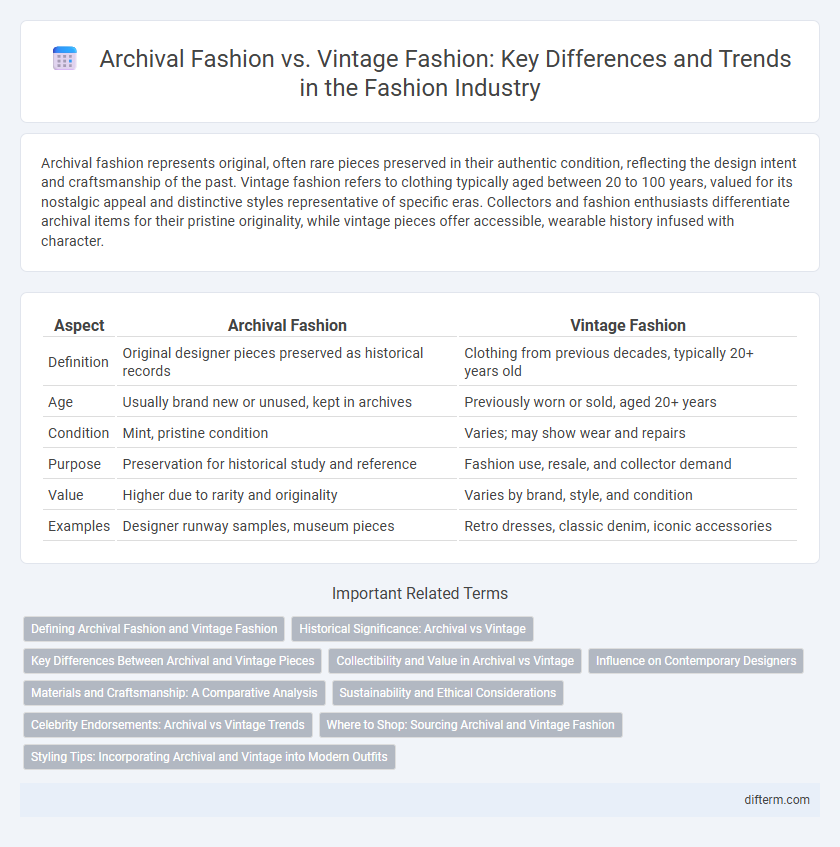Archival fashion represents original, often rare pieces preserved in their authentic condition, reflecting the design intent and craftsmanship of the past. Vintage fashion refers to clothing typically aged between 20 to 100 years, valued for its nostalgic appeal and distinctive styles representative of specific eras. Collectors and fashion enthusiasts differentiate archival items for their pristine originality, while vintage pieces offer accessible, wearable history infused with character.
Table of Comparison
| Aspect | Archival Fashion | Vintage Fashion |
|---|---|---|
| Definition | Original designer pieces preserved as historical records | Clothing from previous decades, typically 20+ years old |
| Age | Usually brand new or unused, kept in archives | Previously worn or sold, aged 20+ years |
| Condition | Mint, pristine condition | Varies; may show wear and repairs |
| Purpose | Preservation for historical study and reference | Fashion use, resale, and collector demand |
| Value | Higher due to rarity and originality | Varies by brand, style, and condition |
| Examples | Designer runway samples, museum pieces | Retro dresses, classic denim, iconic accessories |
Defining Archival Fashion and Vintage Fashion
Archival fashion refers to original pieces preserved by designers or fashion houses, often showcasing exclusive, limited-edition collections stored in brand archives for historical reference. Vintage fashion involves clothing from previous eras, typically at least 20-30 years old, valued for its style, rarity, and cultural significance outside brand ownership. Both archival and vintage fashion emphasize authenticity but differ in origin: archival pieces stem directly from designers' own collections, while vintage items are sourced from past consumer markets.
Historical Significance: Archival vs Vintage
Archival fashion consists of original designer pieces preserved from past collections, showcasing authentic craftsmanship and innovation that directly influenced fashion history. Vintage fashion comprises garments from previous decades that reflect the cultural trends and styles of their respective eras, often carrying nostalgic value and historical context. Both categories offer distinct insights into fashion evolution, with archival pieces emphasizing rarity and provenance, while vintage items highlight period-specific aesthetics and wear.
Key Differences Between Archival and Vintage Pieces
Archival fashion pieces are original garments preserved by designers or fashion houses as part of their official collections, often maintaining pristine condition and representing iconic moments in fashion history. Vintage fashion refers to wearable clothing produced in previous decades, typically 20 to 100 years old, valued for its unique style, craftsmanship, and cultural significance rather than brand origin. Key differences include archival items' direct lineage to designers and historical documentation, while vintage pieces emphasize rarity, trend revival, and personal storytelling within fashion communities.
Collectibility and Value in Archival vs Vintage
Archival fashion pieces often hold higher collectibility and value due to their rarity, original condition, and direct connection to a designer's authenticated past collections. Vintage fashion, while also valuable, varies significantly in worth depending on trends, condition, and historical significance, making it less consistently collectible. Collectors prioritize archival fashion for its provenance and limited availability, driving up market demand and investment potential compared to broader vintage items.
Influence on Contemporary Designers
Archival fashion serves as a direct source of inspiration for contemporary designers by providing authentic patterns and original craftsmanship from past collections, fueling innovation through historical accuracy. Vintage fashion influences modern trends by reinterpreting classic styles and incorporating timeless aesthetics into current designs, creating a cyclical revival of fashion elements. Both archival and vintage fashion contribute to the creative process by preserving heritage while enabling designers to blend tradition with modernity in their collections.
Materials and Craftsmanship: A Comparative Analysis
Archival fashion emphasizes original materials and precise craftsmanship, preserving the designer's initial vision through authentic textiles and construction techniques. Vintage fashion often showcases a blend of varied materials and workmanship quality, reflecting the era's available resources and artisanal methods. The detailed sewing, fabric durability, and authentic trims in archival pieces distinguish them from the more eclectic, sometimes restored nature of vintage garments.
Sustainability and Ethical Considerations
Archival fashion preserves original designer pieces, emphasizing authenticity and sustainable luxury by reducing demand for new production and minimizing environmental impact. Vintage fashion, often sourced from secondhand markets, supports circular economy practices by extending garment lifespan and promoting ethical consumption. Both approaches contribute to sustainability by valuing quality, craftsmanship, and reducing textile waste in the fashion industry.
Celebrity Endorsements: Archival vs Vintage Trends
Celebrity endorsements significantly influence both archival and vintage fashion trends, with archival fashion gaining prestige through high-profile collaborations that spotlight exclusive designer pieces from past collections. Vintage fashion benefits from celebrity-driven social media exposure, popularizing unique, time-worn styles that resonate with sustainable and nostalgic aesthetics. These endorsements enhance consumer demand by associating iconic personalities with authentic, historically-rich fashion narratives.
Where to Shop: Sourcing Archival and Vintage Fashion
Archival fashion pieces can be found in luxury brand boutiques, exclusive designer showrooms, and specialized online platforms like The RealReal and Vestiaire Collective that authenticate and curate rare collections. Vintage fashion is widely available at thrift stores, estate sales, and vintage shops in fashion capitals such as New York, Paris, and Tokyo, as well as on marketplaces like Etsy and Depop. Both archival and vintage fashion require careful attention to provenance and condition when sourcing to ensure the authenticity and quality of the garments.
Styling Tips: Incorporating Archival and Vintage into Modern Outfits
Incorporate archival fashion pieces by mixing classic silhouettes with contemporary accessories to create a balanced, timeless look. Pair vintage garments with modern basics such as sleek denim or minimalist footwear to enhance the nostalgia without overwhelming the outfit. Prioritize statement items like archival coats or vintage scarves to add unique character while maintaining current style trends.
archival fashion vs vintage fashion Infographic

 difterm.com
difterm.com